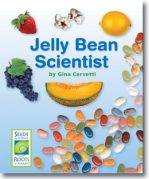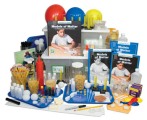Archive for May, 2012
Weather and Water – A 40-Session Science and Literacy Content
Students learn about the water cycle, air and atmosphere, phase change, and weather patterns. They also learn to pose questions, think about what they already know about a topic, use text features as they read, and to write process descriptions and scientific explanations. They learn and use scientific vocabulary such as humidity, precipitation, evidence, and data.
—————————————————————————————————————————————-
Investigation 1 – Air and the Atmosphere
Students discuss what they know about weather and (more…)
MythBusters and Elementary Science Share a Common Goal – Inquiring Minds and Well-supported Explanations
“The results are not publishable, but we take the scientific method seriously because that process of discovery turns out to grid beautifully onto the narrative arc which is what every episode is about.” – Adam Savage, co-host of the Discovery Channel television series MythBusters.
Hear what the stars of MythBusters have to say about the scientific method by watching this video.
The scientific method as used by MythBusters may not be exactly the same as scientists. Their approach, however, helps address (more…)
Rain Shadows and Weather Extremes – Helping Elementary Students Understand Weather Patterns, Rain Shadows and Weather Extremes
A rain shadow is an arid area on the side of a mountain range that is downward (leeward) from prevailing winds. As wind moves humid air toward the mountains, the air is pushed higher in the atmosphere by the slope of the mountains. As the air rises, it cools and water vapor in the air condenses. Much of the water falls as precipitation as the air continues to rise up the windward slope of the mountains. By the time air moves over the other side of the mountains, it has lost most of its humidity and so it does not rain much on the leeward side. The rain shadow effect is what causes the great difference in rainfall between Sequim (pronounced “Squim”, sounds like squid) and Quinault (pronounced “kwin-AWLT”), which are on opposite sides of the Olympic Mountains in the state of Washington.
Check out this map of state annual rainfall totals. You can see how dry it is around the Sequim area, and how wet it is on the southwest side of the Olympics.
There are many examples of rain shadows around the Unites States and the world. In the United States, the biggest rain shadow is (more…)
When I grow up, I want to be a Jelly Belly scientist!
Being a scientist is cool. Being a JELLY BEAN scientist is super cool! Ambrose Lee can attest to this. Ambrose is a food scientist who brainstorms flavor recipes for gourmet jelly beans at Jelly Belly Candy Co. His job is so cool it has been featured in Popular Science magazine. Check out the Jelly Belly web site to learn more about the variety of flavors including crazy ones like:
- Pencil Shavings
- Toothpaste
- Moldy Cheese
- Skunk Spray
Yuck!
The developers of the Seeds of Science/Roots of Reading program were thrilled when Ambrose agreed to be featured in a student book called Jelly Bean Scientist. In the book, readers meet Ambrose and his team of scientists who conduct tests with lab equipment and their own taste buds so the jelly bean flavors they design taste as (more…)
Aquatic Ecosystems – A 40-Session Science and Literacy Unit
Students learn about ecosystems, including the flow of energy and matter in ecosystems, and human impact on ecosystems. They also learn to make connections, pose questions, use text features as they read, and to write scientific descriptions. They learn and use scientific vocabulary, such as interact, decomposer, evidence, and hypothesis.

Investigations include:
1. Exploring Ecosystems
2. Conducting Ecosystem Investigations
3. Food Webs and Energy
4. Human Impact on Ecosystems
Investigation 1: Exploring Ecosystems
Students read Visit to a Pond and make connections between (more…)





